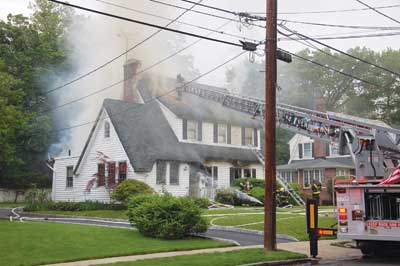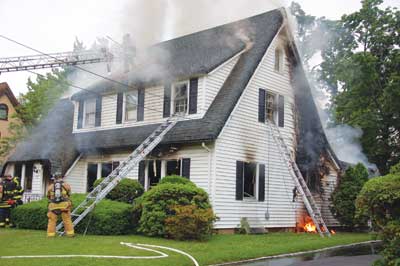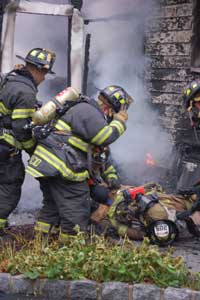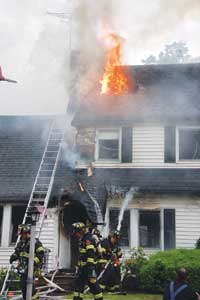By Michael M. Dugan
Firefighters from the Hackensack (NJ) Fire Department encountered a difficult fire that became more difficult when a mutual-aid firefighter went down at the fire. Any fire at which a member operating on the fireground goes down can have a disastrous and long-lasting impact on the fire company and the entire department.
 |
| (1) The building on the exposure 4 or D side appears to have a rear porch. This building has an enclosed rear porch; who did the work? (Photos by Bill Tompkins.) |
The fire in Hackensack was reported in a 2 1⁄2-story private dwelling; on arrival of the first-in engine company, the fire had made significant headway on the rear of the dwelling. The first-in unit struck a second alarm, bringing additional units from Hackensack and mutual aid from Teaneck to the scene. The call for additional units by the first-arriving units was a good call. If you need or might need the additional resources, it is prudent to start them responding to the fire scene immediately. It is safer to have them responding or on scene than it is to try to play catch-up and not have the available resources. If your rapid intervention company (RIC) is a mutual-aid company, it should start in on indications of a working fire such as numerous phone calls or police on the scene reporting a fire.
 |
| (2) The fire appears to be knocked down on the first floor, and the roof is being vented. Because of the peak of the roof, the roof firefighter is operating off of an aerial ladder. |
The fire at this building was reported to have started in a propane barbecue grill on the exterior of the building, in the rear. These types of fires that start on the exterior of the building will almost always involve structural elements and allow the fire to travel behind walls and in voids of the building. This fire got into voids and hidden spaces by traveling the outside of the building and into vents and openings on the building exterior façade. Fires that start this way might show in many different areas of the fire building. This fire was no exception, as can be seen from the photos.
 |
| (3) The members operating in the rear of the fire building witness a firefighter down. A “Mayday” is transmitted, and members begin to stabilize the down member. |
Hoselines were stretched to the front door to protect the interior stairs and the uninvolved areas. The roof was vented, and it appeared that handlines were making progress. Then conditions changed, and heavy black smoke started to push from the attic and vent hole. The fire had traveled from the rear of the house through the walls and involved the attic. A third alarm was called because of the need for additional resources to fight the fire in the attic. More hoselines were going to be needed as well as more firefighters.
Units were working on the fire in the rear, involving a one-story rear setback, when the roof suddenly collapsed, causing a member to fall to the ground. This member fell about 10 feet and landed on his back on top of his self-contained breathing apparatus (SCBA). A Mayday was transmitted, and members immediately began to package the injured member to remove him safely. While the injured member was being packaged, additional members operated a 2 1⁄2-inch hoseline to protect the down firefighter and the members removing him. The member was transported to and spent three days in Hackensack University Medical Center and then went to a rehabilitation center, where he spent several weeks. As of press time, the member has not been able to return to active firefighting.
 |
| (4) Note the 2 1⁄2-inch hoseline operating to protect the down member and the rescue operations. |
No one likes to be assigned as the RIC at a working fire. We all want to be in the action. A well-trained and determined RIC can make a difference, especially when an injured member has a significant spinal injury and needs to be removed with care and caution to prevent permanent damage. The members who operated the hoseline were able to confine the fire enough to allow the RIC the time to carefully package the down firefighter with the knowledge that they were being protected from the fire. This operation went well because of a coordinated and controlled rescue.
This accident happened on a rear one-story setback that was constructed using 2 × 10 dimensional lumber that suffered a catastrophic failure at a substandard attachment point. These types of catastrophic failures are becoming more common because firefighters will work on and in buildings that might have been built and modified by people without licenses, knowledge, or building permits. Dimensional 2 × 10 lumber is considered good construction, and most of us would expect it to hold up at a fire when it is not significantly damaged or exposed. This roof failed with no warning and limited fire damage.
 |
| (5) Fire has traveled from the initial fire area in the rear up the exterior and into voids; the fire is now showing out of the vent hole, and the attic area appears to be well involved. |
The RIC and quick thinking by members who operated to make and protect the rescue were vital to a professional rescue. We always must remember that “The building is our enemy” and treat all buildings accordingly.
MICHAEL M. DUGAN, a 38-year veteran of the fire service, served 27 years in the Fire Department of New York and was the captain of Ladder Company 123 in Crown Heights, Brooklyn, when he retired. As a lieutenant, Dugan served in Ladder Company 42 in the South Bronx. While assigned as a firefighter in Ladder Company 43, in Spanish Harlem, he received the James Gordon Bennett Medal in 1992 and the Harry M. Archer Medal in 1993, the FDNY’s highest award for bravery. He also served as a volunteer firefighter in the Halesite (NY) Fire Department. He is an instructor at FDIC and has been a featured lecturer around the country on topics related to truck company operations, building construction, size-up, and today’s fire service.

